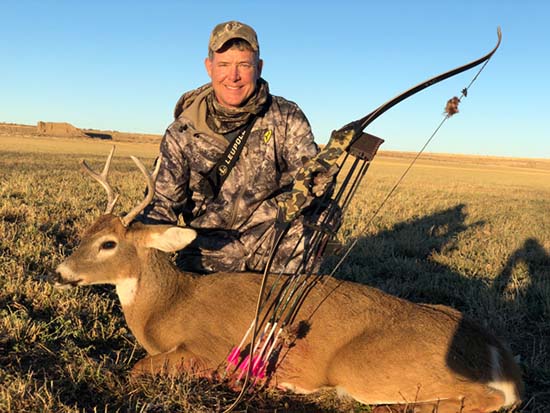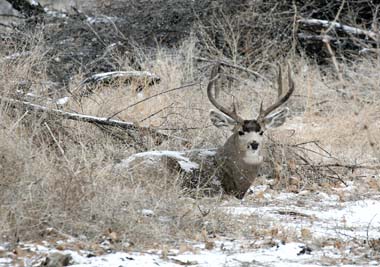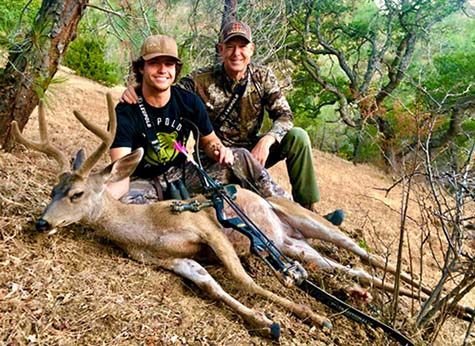
Whitetails are the most frequently hunted species in North America. This is partially due to the fact that they are found in huntable numbers in 43 states. In my opinion these plentiful deer are also one of the most difficult big game species to hit with an arrow. Before I proceed I should explain that I feel the whitetails smaller cousin the Coues deer is the most difficult. Also, I didn’t say most difficult to hunt. I said most difficult to hit with an arrow.
The main reason whitetails are tough to hit is that they spook easily and have amazingly fast reflexes, even more so when they are pressured by hunters or other natural predators. I have been fortunate to have had a lot of my hunts captured on video over the last sixteen years. By watching slow motion video of over fifty whitetails I have shot on video, I can say that less than five percent of those showed no reaction before my arrow struck. The majority of these deer were moving when the arrow hit them. The reason they were moving is that they were beginning their natural evasive maneuver which is to flee. To run a deer needs to load its muscles. To do this a deer must go down first before running. This is commonly called “ducking the string,” when in fact the deer isn’t intentionally ducking at all. It is just trying to get out of there because it heard something close by that wasn’t a natural sound. To test why they duck the string for yourself, it is fun to take a video camera and film yourself. Start in a standing position, then as quickly as you can, RUN! You will see that you will have to drop a foot or more before you can engage your muscles so you are able to run. That is exactly what the deer have to do. Besides dropping, most deer start to whirl as well and usually away from the sound. The reason for this is that deer have exceptional hearing and fast reflexes. For example the speed of sound is close to 1,100 feet per second. An arrow shot out of a fast traditional bow is going about 200 feet per second and slowing down fast down range. A deer’s reaction time is measured in milliseconds, so it is pretty obvious that deer can and usually do react in some way before your arrow arrives on scene.

I have also used my DVR to record other whitetail hunts on TV and find that regardless of the bow used, in slow motion they almost all react as well, so it’s not just me.
I share this because a lot of my friends and acquaintances have shared stories of whitetails they missed. Most say they just missed high. My comment to them is, “maybe you didn’t miss.” The deer just wasn’t there when your arrow got there.
Just last month when I was in Illinois hunting whitetails, I had another deer duck my arrow. It was a big mature whitetail in an area that gets pressured during archery, muzzleloading and rifle season. I had seen the big buck make a scrape a few days before and I decided to move a stand to hunt the scrape. My stand was about eighteen to twenty yards from the scrape and my friend and cameraman Jake Kraus was sitting above me hoping to video the buck if he came in. As luck would have it the same buck ran into the scrape and started raking the scrape with his front right hoof. I drew my Buffalo recurve and released. It was one of those shots that as soon as you let the string drop you just know it is gonna be great. Except it wasn’t, the buck fell over instantly, his spine was severed. It was a fatal shot but the arrow hit way above the tuft of hair I was aiming at. On camera, I said I missed and got lucky to harvest the buck. I was also lucky a spike didn’t step in range first or I would have been eating him instead.
That evening Jake was reviewing the footage and said, “You didn’t miss.” He showed me the footage by advancing it frame by frame and my arrow would have hit the deer right above the heart had he not dropped at the shot. What’s interesting to me is that I would have said the deer didn’t react. It happens so fast that without the video I would have assumed I made a bad shot. The fact is that bad shots sometimes happen to all of us, but in this case the shot was good but the deer’s reaction time almost caused me to miss him or even worse, wound him.
So what can we do to avoid it? One thing we can do is anticipate the deer’s reaction and shoot to hit low on the vitals. That way if a deer ducks the shot will still be fatal.

Other things we can do is to make sure our bows are shooting as quietly as possible. Properly spined arrows, heavy arrows, loose fitting nocks, string silencers and moleskin on bow tips where applicable all help. Additionally, I have shortened the range that I will shoot at a whitetail. Even if you are comfortable shooting at twenty five or thirty yards, the odds of a whitetail not moving that far out before the arrow gets there are slim. Fortunately for us there are situations which can reduce the odds of a deer ducking the string.
Although deer use all their senses to detect danger, we will assume that we are in range of a deer that has not seen us, smelled us or heard u up to the point that we shoot. We will also assume we can draw without being detected. Now all we need to worry about is the deer’s reaction to our shot. We will also assume that our bow is as quiet as we can make it and it only emits a soft strum when shot.
On a quiet day that soft strum sounds loud to a spooky whitetail. So if it is one of those dead calm days where you can hear a squirrel in the leaves a hundred yards away you can plan on a reaction from the deer. On days like this I like to keep shots close and I intentionally pick a spot low on the bottom third of the bucks chest. I also pick a spot a few inches behind the crease of the shoulder. By aiming here if the deer doesn’t drop and start to whirl I will have a low lung hit. By shooting here, if the buck drops and starts to whirl I will still have a fatal shot. To improve the odds of a deer not reacting or having a minimal reaction it is bet to shoot on windy, rainy or snowy days. On these days the deer’s sense of hearing is constantly bombarded by the sound of rain or snow on leaves and branches bumping and other associated sounds. On these days the deer’s reaction is usually less drastic, if there is any reaction at all.

Other variables that reduce or stop a deer from reacting is if it is traveling with other deer. A deer traveling with one or more deer constantly make some noise going through the woods. I have noticed a lone deer is more likely to react to the sound of the bow than a deer with company. A deer that is distracted because it is rubbing a tree, rutted up, distracted by other deer, walking through leaves or some other loud environment or making a scrape are also usually less likely to react drastically.
Even though the buck in the beginning of this article did drop almost seven inches as near as we could measure from looking at the video as with all animals and hunting situations each one is unique. I once missed a buck in Montana that ducked completely out of the flight of my arrow. I had never seen a reaction that drastic. In speaking with other hunters and showing our footage, we learned that same buck had been missed a week earlier by another bowhunter. Talk about a quick reaction! The best thing we can do as bowhunters who deeply respect the game we pursue is to keep our shots close and prepare for the worst case scenario. In my opinion it is always best to shoot at the bottom third of any animal you shoot at with a bow.

Even though whitetails get the most press as being the most common arrow duckers, the fact is that I have seen almost all big game react in some degree to the noise of a bow being shot. I have witnessed Antelope, Mule Deer, Blacktail Deer, Elk, Sheep, and even moose, all react to traditional bows being shot.
Even an arrow shot through the quietest longbow is still susceptible to being ducked by an animal on a quiet day. Even more so if that animal is alert. I have also been amazed on more than one occasion when small game like a rabbit has dropped and whirled before my arrow hit its mark. The most notorious small game animals are bobcats, coyote and fox. I always try and pick a spot low on the chest and back a few inches on these quick critters as well. Again, video has shown me time and time again that there is a lot more happening when we shoot than we usually realize with our eyes.

I know some people might be thinking that they have never had a deer react to the sound of a quiet longbow or recurve. If you haven’t, you are lucky, the majority of deer do react in some way before the arrow hits. Also, without a video camera it is hard to say how much they react. I only learned from watching a lot of deer reactions in slow motion. Also, if your beating yourself up over a deer you missed high on, maybe….”YOU DIDN’T MISS” Good luck, Have fun and aim low!…
By: Fred Eichler
Everything Eichler














.jpg)
